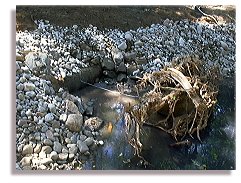Wood, Rock, and
Cable?
By Damien Barstead
In past issues of the Creekside News, I have stressed the importance of woody debris
in Haig-Brown Kingfisher Creek. Primarily, large woody debris (LWD) is needed to provide
fish with shelter from both predators and the sun. As well, LWD such as large stumps and
root-wads will add complexity to the stream, offering a larger variety of habitat for salmonids.
The Haig-Brown Kingfisher Creek Project has been placing
woody debris throughout its new stream channel, but the challenge of how to prevent the newly
placed wood from floating up and washing away during high waters has been a concern.

A large log "keyed" into the bank.
Two methods have been used so far to ensure that the valuable LWD will remain
where it has been placed. First, much effort has been made to "key" large logs into the stream
banks as they are being constructed. This is usually done by digging holes into the new banks,
placing the log into position, back-filling around the log, and finally, armouring the sides and top
of the log with cobble which is
compacted in and around the area.
This first method serves a double function. First, it seems to permanently secure the
logs into the bank, and second, it provides an anchor for other LWD, such as root-wads, that
might otherwise be insecure.
|

Rootwads are fastened to other LWD in
the bank by
attaching a metal cable to
both pieces of wood.
These root-wads would be prone to washing away over time, without this or some other
type of anchor. In several previous instances, a metal cable has been used to secure these
root-wads in their respective pools in the Haig-Brown Kingfisher Creek Restoration Project.
Although not used in every pool, this method will definitely secure the large pieces
of wood in position in some of the more significant pools. One end of the cable length is
wrapped and secured around the logs that have been keyed into the bank. The other end is then
attached in a similar fashion around the gnarled root-wads, thus securing the root-wad to the log
and in the pool. Truthfully, it is a very straight-forward, effective, and cheap way to fasten LWD
in place.
One major concern of those involved with this project is
that the new creek channel remain functional in roughly the same way it has been planned, for
many years to come. Using metal cable to secure LWD into position is just one instance where
we can take comfort in the fact that our attempt at creating fish habitat won't be washed away
with the arrival of high waters.
Top of page.
|

